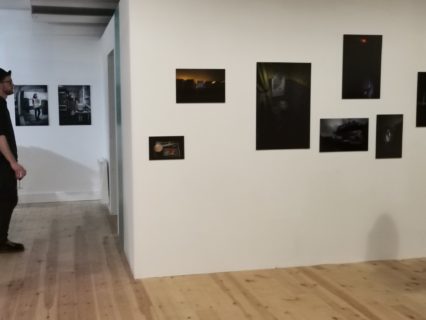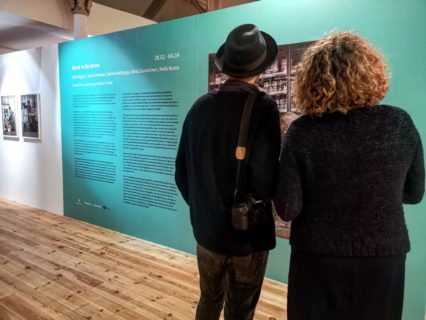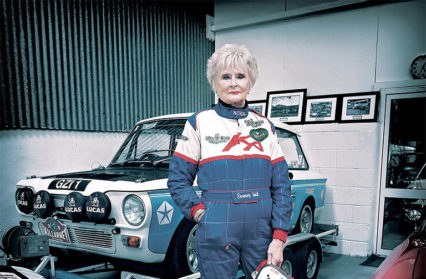Martha O’Brien was at the Ffotogallery in Cardiff to review Work to Be Done, a new exhibition of images exploring the hierarchies of the work space and what work means to a functioning society steeped in gender coded territories.
‘Don’t think this is utopia,’ says Johan Bävman addressing the room on the opening night of Work to Be Done, exhibited at Ffotogallery. ‘It isn’t. I wouldn’t be standing here if it were women in my pictures. And you,’ he gestures to Beta Bajgart, ‘wouldn’t be stood here if it were men in your pictures.’
It’s a simple statement; perhaps even an intuitive one. Here, though, in a room full of photographs of men and women performing tasks that subvert our expectations of manhood and womanhood – of fatherhood and motherhood – it’s easy to be swept up in our admiration for the subjects of these photographs. It’s easy to feel that what we’re seeing around us is a finished product, a haven of gender equality. The reality, though, is that these photographs are doing just what their subjects are: they’re working.
Work to Be Done is the latest curation from Whack ‘n’ Bite, a visual arts collective founded by Finnish duo Tuula Alajoki, a curator, and Johanna Havimäki, a visual arts designer. The exhibition is a part of the wider ‘A Woman’s Work’ project, in partnership with Ffotogallery in Cardiff, the Gallery of Photography in Dublin, and Kaunas Photography Gallery in Lithuania. The project uses photography and digital media to question and address the presentation – and oftentimes, simply the presence – of women in what we tend to think of as male-orientated ‘heavy industries’.
 Work to be Done takes this ethos a step further. It’s not just women in heavy industries exhibited here, but women in an array of jobs traditionally deemed ‘masculine’ or dominated by men – and it’s not just women at work, it’s men, too, in their domesticity doing what we’ve been encouraged to regard as ‘a woman’s work’.
Work to be Done takes this ethos a step further. It’s not just women in heavy industries exhibited here, but women in an array of jobs traditionally deemed ‘masculine’ or dominated by men – and it’s not just women at work, it’s men, too, in their domesticity doing what we’ve been encouraged to regard as ‘a woman’s work’.
As we look on Mikko Suutarinen’s truck driving women and Johan Bävman’s food-shopping fathers, it feels natural to reflect on what Whack’n’Bite tell us in their introduction to this exhibition: that ‘gender coded territories are no illusion. The gulf between the territories, at both work and home, is knit together with myriad patterns. It is a privilege to be able to choose one’s profession and workplace’.
A privilege. It’s not the first word that comes to mind when watching Katrīna Neiburga’s ‘Traffic’, an experiment of ‘anthropological “archaeology”’, as Solvita Krese puts it. The short film cuts two parts of Neiburga’s project together: the first is her stint as a cab driver in Latvia, talking and listening to her passengers’ thoughts and confessions – some welcome, others less so. One passenger tells Neiburga that he wouldn’t usually take a cab with a woman driver: ‘I only got in this one time because of your beautiful legs’.
‘I never once imagined that I’d be driven by a woman,’ says another. ‘Never.’
This misogyny isn’t just expressed by the passengers in the cab: ‘I’m rather of the opinion that a woman’s place is in the home,’ says one woman cab driver at work, in the second part of Neiburga’s project, a series of interviews with women taxi drivers.
The film communicates the complicated interaction between ideology and action and the long-lasting impact of sexist rhetoric that seeps into women’s relationship to the work that they do. The relationship between work and gender in Neiburga’s work is not one of societal repression and liberation, but a confusing and uncomfortable entanglement of blurred gender lines: in ‘Traffic’, to be a working woman in a society that regards your gender as incongruent with your work is not to diversify the image of that work by putting yourself into it, but to fade into a male-centric stereotype and have that womanhood effaced and, to be simultaneously undermined and objectified by those who regard you as out of place.
 Bävman warns us not to ‘applaud’ the men in his photographs: ‘women have done this for years and never been applauded’. Across the other side of the gallery, ‘Swedish Dads’ portrays men playing with their children, washing them, but also going about their daily lives with and around them. We see a dad with his child strapped to his front practicing pull-ups in the doorway while another runs on the treadmill, his child in a baby carrier next to him. These aren’t super-dads, Bävman reminds us, nor should we think of Sweden as a superior nation when it comes to parental leave: though the country has progressive and open laws about maternity and paternity leave, only fourteen percent of Swedish parents split this parental leave evenly. What makes these photographs so remarkable is their anomalous presentation of fatherhood – one that is tender, playful, and practical. These fathers are nurturing and loving, busy and hands-on in all the ways we expect single mothers to behave. And yet, it is this subversion, this notable difference of traditional portrayals of fatherhood to Bävman’s images, that puts these photographs to work.
Bävman warns us not to ‘applaud’ the men in his photographs: ‘women have done this for years and never been applauded’. Across the other side of the gallery, ‘Swedish Dads’ portrays men playing with their children, washing them, but also going about their daily lives with and around them. We see a dad with his child strapped to his front practicing pull-ups in the doorway while another runs on the treadmill, his child in a baby carrier next to him. These aren’t super-dads, Bävman reminds us, nor should we think of Sweden as a superior nation when it comes to parental leave: though the country has progressive and open laws about maternity and paternity leave, only fourteen percent of Swedish parents split this parental leave evenly. What makes these photographs so remarkable is their anomalous presentation of fatherhood – one that is tender, playful, and practical. These fathers are nurturing and loving, busy and hands-on in all the ways we expect single mothers to behave. And yet, it is this subversion, this notable difference of traditional portrayals of fatherhood to Bävman’s images, that puts these photographs to work.
‘The most important thing for me,’ says Bajgart of her book, A Woman’s Work, ‘is that this book, this collection, serves for young people, young women, young children, so that they can see what is possible’. The stream of women photographed, displayed in a line across the wall, varies from astrophysicists to racecar drivers – from music producers to veterinary nurses. The less male-centric occupations photographed by Bajgart remind us of the harsh truth, that even those jobs that women are not necessarily held back from doing because of their gender, are still dominated by men.
The impact of Bajgart’s work is strengthened in its pairing with Nella Nuora’s ‘Midwife’ and Mikko Suutarinen’s ‘Truckers’. The subjects of these photographs break through the gendered territories laid out by society. Nuora’s work takes the emotion and feminine bonds often closely associated with midwifery and confronts us with the logic and science of the occupation – something we often regard as masculine and separate to caregiving occupations. A number of the photographs in ‘Truckers’, meanwhile, are dark and near-inscrutable: long-exposure shots force us to squint to discern the women driving these vehicles. And yet, in others, we are stared at confidently, even judged by the subjects. The project vacillates between visibility and invisibility, forcing us to regard these women, and persuading us to look harder to notice them where they’re not overtly visible.
A woman’s work ultimately leaves us questioning the legitimacy behind questions of gendered work, and how much these definitions limit the work that we see done. The binary relationship between womanhood and manhood in this curation is compromised as we see gender roles confused and blurred. At times, however, it is also straightforwardly subverted in the labeling of ‘men’s’ and ‘women’s’ work. This curation is just one branch of a much bigger and wider question surrounding work, gender, and what society regards as acceptable between the two.
The issue of gendered work isn’t solved by showcasing photography of this kind, but that is not what these artists are suggesting. Whack’n’Bite’s curation highlights that very fact: that there is, indeed, Work to Be Done.
(Images credit: Phil Scully)
This article is presented in partnership with Image Works: Research and Practice in Visual Culture, a public initiative of the School of English, Communication and Philosophy at Cardiff University.





 Enjoyed this article? Support our writers directly by buying them a coffee and clicking this link.
Enjoyed this article? Support our writers directly by buying them a coffee and clicking this link.








